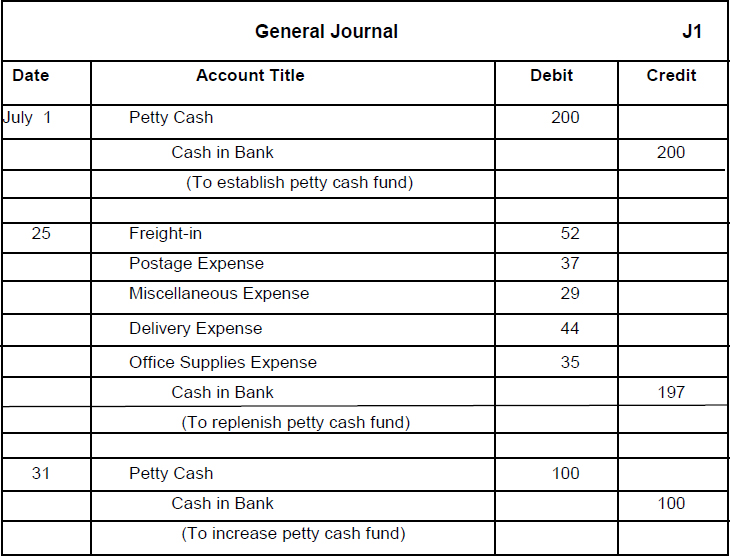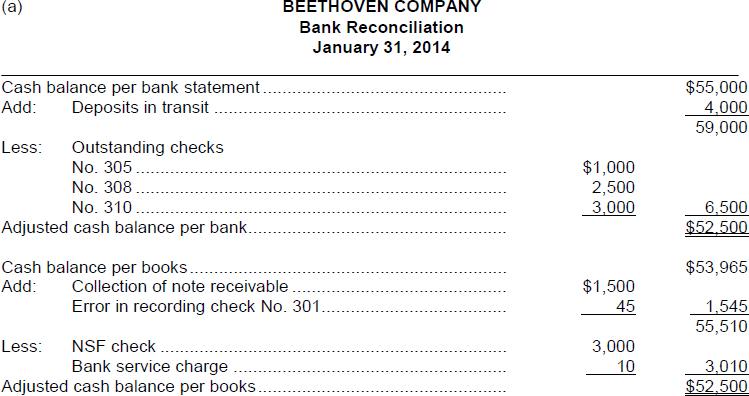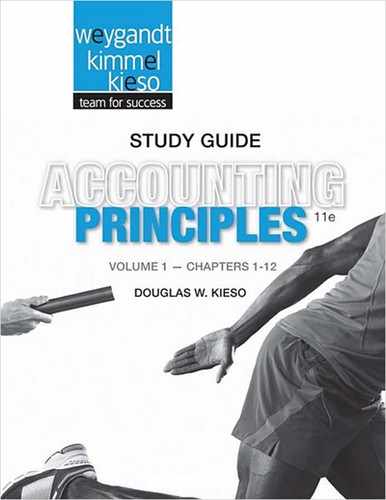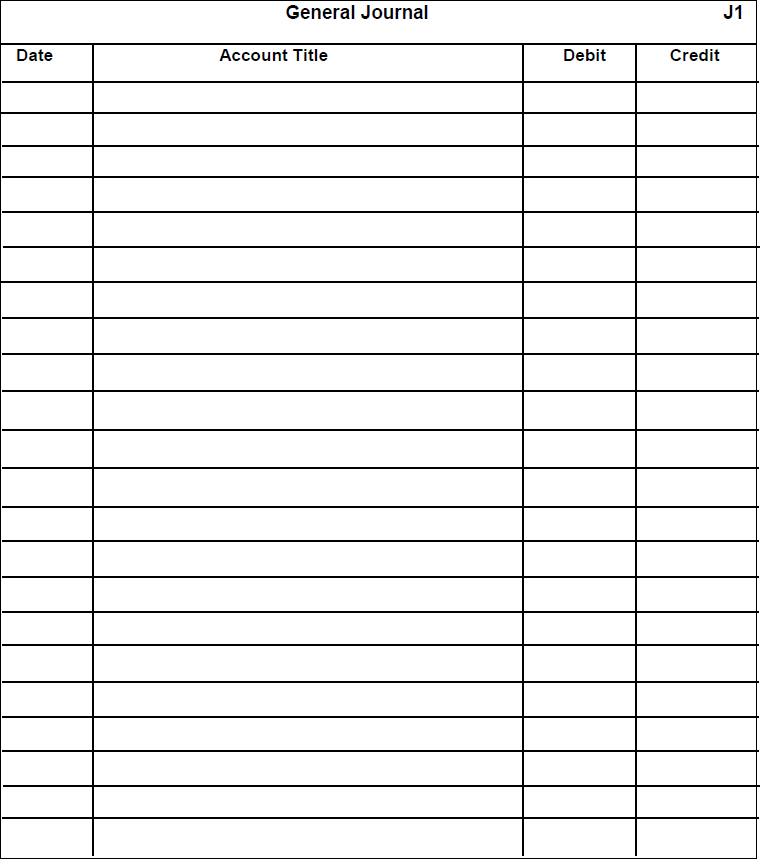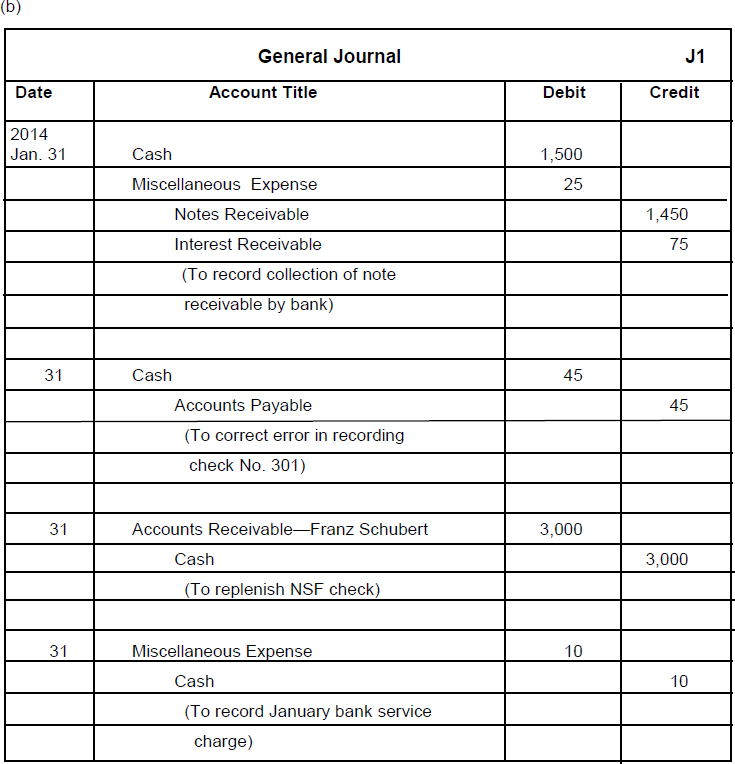Chapter 8
FRAUD, INTERNAL CONTROL, AND CASH
CHAPTER LEARNING OBJECTIVES
After studying this chapter, you should be able to:
1. Define fraud and internal control.
2. Identify the principles of internal control activities.
3. Explain the applications of internal control principles to cash receipts.
4. Explain the applications of internal control principles to cash disbursements.
5. Describe the operation of a petty cash fund.
6. Indicate the control features of a bank account.
7. Prepare a bank reconciliation.
8. Explain the reporting of cash.
*9. Compare the accounting procedures for fraud, internal control, and cash under GAAP and IFRS.
![]()
PREVIEW OF CHAPTER 8
The organization and content of Chapter 8 are as follows:

![]()
CHAPTER REVIEW
- (L.O. 1) A fraud is a dishonest act by an employee that results in personal benefit to the employee at a cost to the employer.
- Opportunity, financial pressure and rationalization are the three main factors that contribute to fraudulent activity (the fraud triangle).
- The most important element of the fraud triangle is opportunity. Opportunities occur when the workplace lacks sufficient controls to deter and detect fraud. A second factor that contributes to fraud is financial pressure. Employees sometimes commit fraud because of personal financial problems or because they want to lead a lifestyle they cannot afford. Rationalization occurs when employees justify fraud for reasons like “being underpaid.”
- The Sarbanes-Oxley Act (SOX) is one of the most important laws to be passed in decades as it forced companies to pay more attention to internal controls.
- (L.O. 1) Internal control consists of all the related methods and measures adopted within a business to (a) safeguard its assets and (b) enhance the accuracy and reliability of its accounting records.
- (L.O. 2) An essential characteristic of internal control is the establishment of responsibility to specific employees. Control is most effective when only one person is responsible for a given task.
- The rationale for segregation of duties is this: The work of one employee should, without a duplication of effort, provide a reliable basis for evaluating the work of another employee.
- The responsibility for related transactions should be assigned to different individuals, and the responsibility for establishing the accountability for an asset should be segregated the physical custody of that asset.
- Documentation procedures provide evidence that transactions and events have occurred.
- Physical controls relate primarily to the safeguarding of assets and include such measures as safes for the storage of cash prior to deposit, bank vaults for the deposit of cash, safety deposit boxes for the storage of important business papers, and locked warehouses for inventories. Other physical controls include electronic burglar alarms, television monitors, sensors on garments, cash registers, time clocks and built-in hardware controls.
- Most systems of internal control provide for independent internal verification. This principle involves the review of data prepared by employees.
- In large companies, independent internal verification is often assigned to internal auditors. Internal auditors are employees of the company who evaluate the effectiveness of the company's system of internal control on a continuous basis.
- Other control measures include bonding of employees who handle cash, rotating employees' duties, and requiring employees to take vacations and conducting through background checks.
Limitations of Internal Control
14. The concept of reasonable assurance rests on the premise that the costs of establishing control procedures should not exceed their expected benefits.
15. The human element is also an important factor in every system of internal control. A good system can become ineffective through employee fatigue, carelessness, or indifference.
16. Collusion may result when two or more individuals work together to get around prescribed controls and may significantly reduce the effectiveness of a system.
Cash
17. Cash is readily convertible into any other type of asset, and is therefore most susceptible to fraudulent activities. To safeguard cash and to assure the accuracy of the accounting records for cash, effective internal control over cash is imperative.
Cash Receipts Controls
18. (L.O. 3) The application of internal control principles to cash receipts transactions includes: (1) only designated personnel should be authorized to handle or have access to cash receipts; (2) different individuals should be assigned the duties of receiving cash, recording cash receipt transactions, and having custody of cash; (3) documents should include remittance advices, cash register tapes, and deposit slips; (4) cash should be stored in company safes and bank vaults, access to storage areas should be limited to authorized personnel, and cash registers should be used; (5) daily cash counts and daily comparisons of total receipts should be made; and (6) all personnel who handle cash receipts should be bonded and required to take vacations.
19. Control of over-the-counter receipts is centered on cash registers that are visible to customers. A company can also use a cash over and short account to keep track of any cash discrepencies.
Cash Disbursements Controls
20. (L.O. 4) Generally, internal control over cash disbursements is more effective when companies pay by check rather than by cash, except for incidental amounts that are paid out of petty cash.
21. The application of internal control principles to cash disbursements transactions includes: (1) only designated individuals should be authorized to sign checks and approve invoices; (2) different individuals should be assigned the duties of approving an item for payment and paying it; (3) prenumbered checks should be used and each check should be supported by an approved invoice or other document; (4) blank checks should be stored in a safe and access should be restricted to authorized personnel, and a check writer machine should be used to imprint the amount on the check in indelible ink; (5) each check should be compared with the approved invoice before it is issued; and (6) bond personnel who handle cash, require employees to take vacation, and conduct background checks.
Voucher System
22. A voucher system is often used to enhance the internal control over cash disbursements. A voucher system is an extensive network of approvals by authorized individuals acting independently to ensure that all disbursements by check are proper. A voucher system includes the use of authorization forms called vouchers which are recorded by the accounting department in the voucher register.
Petty Cash Fund Controls
23. (L.O. 5) A petty cash fund is a cash fund used to pay relatively small amounts.
a. The operation of the fund, often called an imprest system, involves (1) establishing the fund, (2) making payments from the fund, and (3) replenishing the fund.
b. Accounting entries are required when (1) the fund is established, (2) the fund is replenished (this entry does NOT affect Petty Cash), and (3) the amount of the fund is changed.
Control Features: Use of a Bank
24. (L.O. 6) The use of a bank minimizes the amount of currency that must be kept on hand and therefore contributes significantly to good internal control over cash.
25. A check is a written order signed by the depositor directing the bank to pay a specified sum of money to a designated recipient. The three parties to a check are as follows:
a. The maker (or drawer) who issues the check.
b. The bank (or payer) on which the check is drawn.
c. The payee to whom the check is payable.
26. A bank statement shows (a) checks paid and other debits charged against the account, (b) deposits and other credits made to the account, and (c) the account balance after each day's transactions.
27. A bank debit memoranda is usually included with the bank statement to indicate charges against the depositor's account such as a bank service charge, cost of printing checks, issuing traveler's checks, and when a previously deposited customer's check “bounces” because of insufficient funds (NSF check).
28. A bank credit memoranda shows such items as the collection of a note receivable for the depositor by the bank or interest earned.
Reconciling the Bank Account
29. (L.O. 7) A reconciliation of a bank account is necessary because the balance per bank and balance per books are seldom in agreement. The lack of agreement may be the result of time lags and errors.
30. To obtain maximum benefit from a bank reconciliation, the reconciliation should be prepared by an employee who has no other responsibilities pertaining to cash.
31. In reconciling the bank statement, it is customary to reconcile the balance per books and balance per bank to their adjusted cash balances. The reconciliation schedule consists of two sections. The steps in preparing a bank reconciliation are:
a. Determine deposits in transit.
b. Determine outstanding checks.
c. Note any errors discovered.
d. Trace bank memoranda to the records.
32. Each reconciling item used in determining the adjusted cash balance per books should be recorded by the depositor.
Electronic Funds Transfer
33. Electronic Funds Transfer (EFT) is a disbursement system that uses wire, telephone, telegraph or computer to send cash from one location to another.
Reporting Cash
34. (L.O. 8) Cash on hand, cash in banks, and petty cash are often combined and reported simply as Cash. Because it is the most liquid asset, cash is listed first in the current asset section of the balance sheet under the title “cash and cash equivalents.” Cash equivalents are highly liquid investments, with typical maturities of 3 months or less when purchased, that can be converted into a specific amount of cash. They include money market funds, money market savings certificates, bank certificates of deposit, and U.S. Treasury bills and notes.
A Look at IFRS
*35. (L.O. 9) Many have been critical of GAAP for its “rules-based” approach because it may be easier to commit fraud than the “principles-based” approach of IFRS.
*36. The SOX internal control standards apply only to companies listed on U.S. exchanges.
*37. IFRS defines both cash and cash equivalents as follows:
• Cash is comprised of cash on hand and demand deposits.
• Cash equivalents are short-term, highly liquid investments that are readily convertible to known amounts of cash and which are subject to an insignificant risk of changes in value.
![]()
![]()

REVIEW QUESTIONS AND EXERCISES
Indicate whether each of the following is true (T) or false (F) in the space provided.
![]()
MULTIPLE CHOICE
Circle the letter that best answers each of the following statements.
- (L.O. 1) Which of the following is not considered a part of the fraud triangle?
- Opportunity
- Genetics
- Rationalizations
- Financial Pressures
- (L.O. 1) Which of the following is not considered a part of the definition of internal control?
- Safeguard its assets.
- Enhance the accuracy and reliability of its accounting records.
- Assignment of responsibility to specific individuals.
- The plan of organization.
- (L.O. 2) An example of poor internal control is:
- The accountant should not have physical custody of the asset nor access to it.
- The custodian of an asset should not maintain or have access to the accounting records.
- One person should be responsible for handling related transactions.
- A salesperson should make the sale, and a different person ships the goods.
- (L.O. 2) Independent internal verification is not involved when an independent person:
- reconciles the cash balance per books with the cash balance per the bank.
- reviews the accounts receivable subsidiary ledger.
- makes a surprise count of the petty cash fund.
- is responsible for making sales and recording the entries in the books.
- (L.O. 2) Internal auditors

- (L.O. 2) Which of the following is not a physical control?
- Bonding employees who handle cash.
- Employee identification badges.
- Safety deposit boxes.
- Fences around storage areas.
- (L.O. 2) Which of the following is not an example of an effective internal control measure?
- Requiring employees to take vacations.
- Prenumbering sales invoices.
- Bonding employees who handle cash.
- Permitting collusion among employees.
- (L.O. 2) Which of the following statements concerning the limitations of internal control is correct?
- The human factor is unimportant.
- The costs of establishing control procedures should not exceed their expected benefit.
- Collusion among employees may result in more effective control.
- A system of internal control should be infallible.
- (L.O. 3) Effective control over cash receipts transactions does not result when:
- cash registers are used in executing cash receipts transactions.
- personnel who handle cash receipts are bonded.
- company safes and vaults are used for the storage of cash prior to deposit.
- one individual is responsible for the receiving, recording, and custody of cash receipts.
- (L.O. 3) Independent internal verification over cash receipts transactions does not occur when:
- cashiers make daily cash counts of cash register totals.
- the treasurer's office makes daily comparisons of total receipts and receipts deposited in the bank.
- an internal auditor reconciles bank and book balances monthly.
- none of the above.
- (L.O. 3) Storing cash in a company safe is an application of which internal control principle?
- Segregation of duties.
- Documentation procedures.
- Physical controls.
- Establishment of responsibility.
- (L.O. 4) All but one of the following statements about internal control over cash disbursements are correct. The incorrect statement is:
- More effective internal control results when payments are made by check rather than in cash.
- The bank reconciliation should be prepared by the employee who writes the checks.
- The use of a bank contributes significantly to good internal control over cash disbursements.
- Prenumbered checks should be used and all checks in a series should be accounted for.
- (L.O. 4) An application of good internal control over cash disbursements is:
- Payment by check, rather than by cash.
- Blank checks should be stored in the treasurer's desk.
- Each check should be compared with the approved invoice after the check is issued.
- Check signers should record the cash disbursements.
- (L.O. 5) When making a payment from the petty cash fund for postage stamps, the following journal entry is made.

- (L.O. 5) A $100 petty cash fund contains $92 in receipts and $7 in cash. The entry to record replenishments of the fund will include a debit to:
- Petty Cash for $100.
- Cash Over and Short for $1.
- Expenses for $93.
- Petty Cash for $8.
- (L.O. 6) Which of the following statements is false?
- The use of a bank contributes significantly to good internal control over cash.
- Many companies have only one bank account.
- Use of a bank minimizes the amount of currency that must be kept on hand.
- A company can safeguard its cash by using a bank as a depository and clearing house for checks received and checks written.
- (L.O. 6) The person who issues the check is known as the:
- maker.
- payer.
- payee.
- drawee.
- (L.O. 6) A bank may issue a credit memoranda for:
- a bank service charge.
- an NSF (not sufficient funds) check from a customer.
- the collection of a note receivable for the depositor by the bank.
- the cost of printing checks.
- (L.O. 7) Which of the following reconciling items would be added to the balance per bank statement to determine the adjusted balance per bank?

- (L.O. 8) Cash equivalents are highly liquid investments that can be converted into a specific amount of cash with typical maturities of:
- 1 month or less when purchased.
- 3 months or less when purchased.
- 6 months or less when purchased.
- 1 year or less when purchased.
![]()
Match each term with its definition by writing the appropriate letter in the space provided.

![]()
EX. 8-1 Avison Company uses a petty cash fund for small cash disbursements. The following transactions occurred during July.
| July 1 | Established a petty cash fund of $200. |
| 4 | Paid freight costs on goods purchased $52. Issued receipt ticket No. 1. |
| 8 | Paid $37 postage expense. Issued receipt ticket No. 2. |
| 15 | Paid miscellaneous expenses $29. Issued receipt tickets Nos. 3 and 4. |
| 20 | Paid delivery costs on goods sold $44. Issued receipt ticket No. 5. |
| 24 | Paid $35 for office supplies expense. Issued receipt ticket No. 6. |
| 25 | Replenished petty cash fund by issuing a check for $197. |
| 31 | Increased petty cash fund to $300. |
Instructions
Journalize the entries that affect the Petty Cash account by using the general journal on the next page.
EX. 8-2 (L.O. 6) As of January 31, 2014, the Beethoven Company had the following facts concerning cash in bank.
- Balance per bank, $55,000.
- Balance per books, $53,965.
- Deposits in transit, $4,000.
- Outstanding checks: No. 305, $1,000; No. 308, $2,500; and No. 310, $3,000.
- Error: Check No. 301 for $3,416 was correctly paid by the bank but was recorded by the company for $3,461. This check was a payment on account to a creditor.
- Two bank debit memoranda are unrecorded.
- NSF check from Franz Schubert for $3,000 on account.
- A bank service charge of $10.
- One bank credit memorandum is unrecorded. A note receivable for $1,450 plus interest of $75 was collected by the bank. The bank charged $25 for this service. The interest has been accrued by Beethoven Company.
Instructions
(a) Prepare a bank reconciliation for the Beethoven Company for the month ended January 31, 2014.
(b) Journalize the adjusting entries for Beethoven Company on January 31, 2014.
(a)
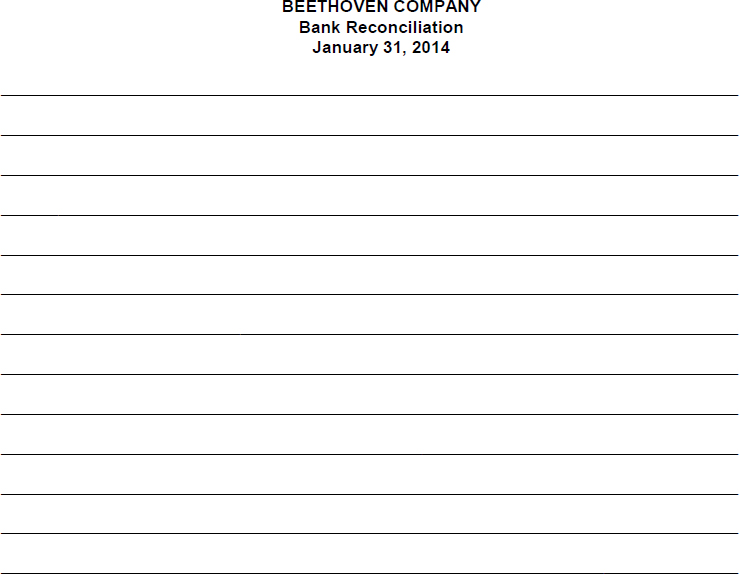
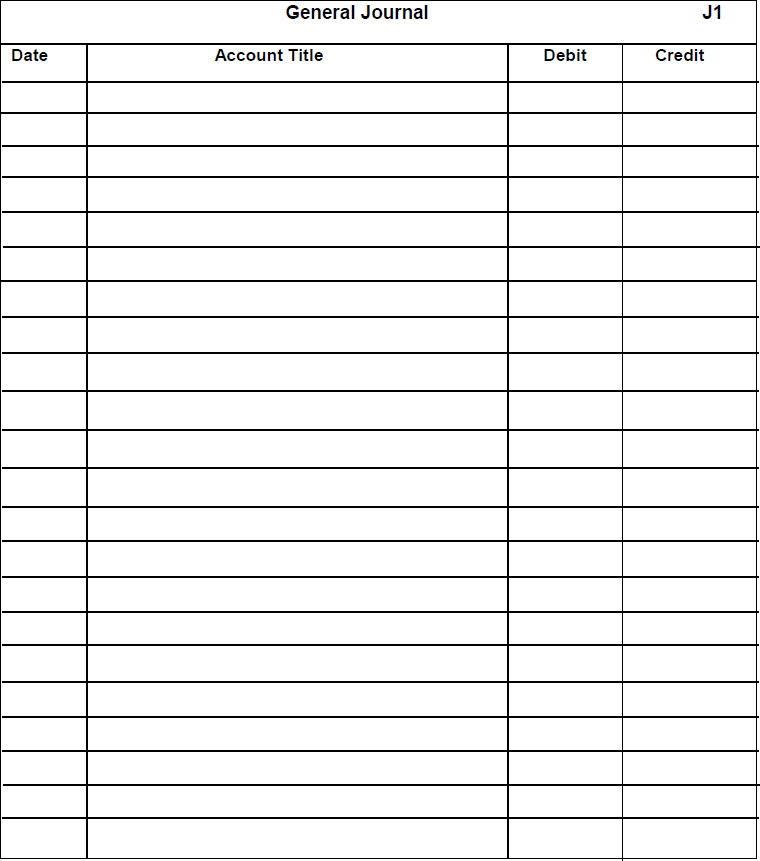
![]()
SOLUTIONS TO REVIEW QUESTIONS AND EXERCISES
| 1. (F) | The three main factors (the fraud triangle) that contribute to fraudulent activity are: Opportunity, Financial Pressure and Rationalizations. |
| 2. (T) | |
| 3. (T) | |
| 4. (F) | The responsibility for related transactions should be assigned to different individuals. |
| 5. (T) | |
| 6. (T) | |
| 7. (F) | Internal auditors are employees of the company. |
| 8. (T) | |
| 9. (T) | |
| 10. (F) | Collusion results when two or more individuals circumvent prescribed controls and may significantly reduce the effectiveness of the system. |
| 11. (T) | |
| 12. (F) | For good internal control, all persons who handle cash should be required to take vacations. |
| 13. (T) | |
| 14. (T) | |
| 15. (F) | An entry is not made every time petty cash is used. |
| 16. (F) | The maker and drawer are one and the same. The three parties to a check are the maker (or drawer), the bank (or payer), and the payee. |
| 17. (F) | A debit memoranda shows charges to the account such as a bank service charge, and the cost of printing checks. A credit memoranda will show the collection of a note receivable. |
| 18. (T) | |
| 19. (T) | |
| 20. (F) | Outstanding checks are subtracted from the balance per bank to obtain the adjusted balance per bank. |
| 21. (T) | |
| 22. (F) | Cash is generally listed first in the current asset section of the balance sheet. |
MULTIPLE CHOICE
MATCHING
- j.
- e.
- a.
- d.
- b.
- i.
- h.
- f.
- c.
- g.
EXERCISES
EX. 8-1
